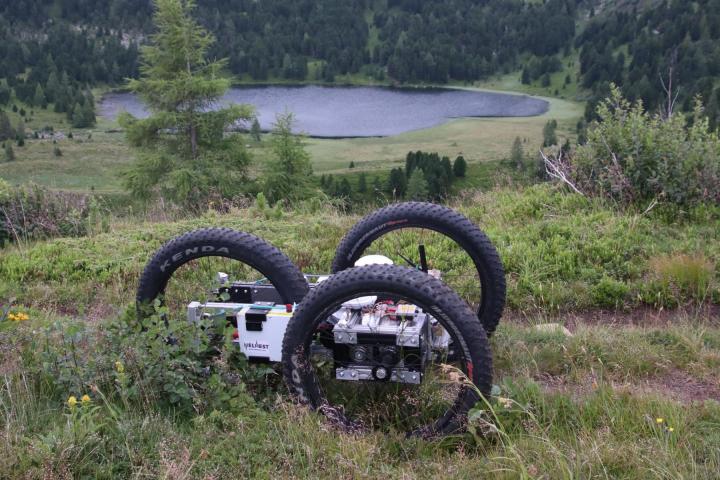
Helhest – named after the mythical three-legged horse from Danish mythology – is not just another experimental prototype. The development team of robotics engineers designed it with an emphasis on low cost, high durability, and speed. “We wanted a robot that could handle difficult terrain, was inexpensive, fast, and robust enough to continue functioning even after being overturned,” explains Karel Zimmermann from the Department of Cybernetics at Faculty of Electrical Engineering , who, together with Prof. Tomáš Svoboda and Ing. Bedřich Himmel, is behind the robot’s creation.
The robot can reach speeds of up to 20 km/h, carry up to 100 kg, and overcome obstacles up to half a meter high. Thanks to its design, it can flip itself back over and continue its mission. In extreme conditions, it can even operate "upside down." The modular approach is key: the basic version of the robot is aimed, for example, at research institutions that need robust hardware for their own algorithms. Autonomous navigation is based on passive sensors – primarily cameras – which allows for operation even without GPS and reduces visibility in the spectrum. Potential applications include military and rescue reconnaissance, transport of chemical detection sensors, underground operations, and assistance in difficult-to-access terrain.
It can handle black ski slopes in the Alps and even a fall into a stream.
During the week of 7 July, 2025, the team participated in an international robotic team exercise in the Austrian mountains, organized by the Austrian Army and Graz University of Technology (TU Graz). In challenging terrain with steep slopes and an altitude of over 2,000 meters above sea level, the Helhest robot proved its strengths.
"The design attracted considerable interest among foreign experts. Thanks to its three contact points, Helhest had stable traction in terrain where four-wheeled machines lost some contact with the ground," says Prof. Tomáš Svoboda. The robot was able to climb extremely steep terrain in manual mode, comparable to the slope of a black ski slope, and also proved itself in emergency situations – when it fell into a stream, it did not stop and continued driving.
"We liked the fact that it wasn't a competition, but rather a joint exercise for robotics groups and data collection in an extreme environment. This was very valuable for further development and will enable us to make rapid progress," explains Prof. Svoboda, who is pleased that other robots from thef aculty, the tracked MARV and the wheeled Husky, tested by Prof. Jan Faigl's team from the Center for Artificial Intelligence at CTU, also performed well in the demanding comparison with models from foreign universities. "Our robots demonstrated excellent technological permeability even at high altitudes and in demanding mountainous terrain," adds Prof. Svoboda.
The team is currently fine-tuning advanced autonomous behavior based solely on passive sensors (cameras, IMUs, magnetometers) without the use of LiDAR. This approach not only reduces costs but also enables less detectable operations, e.g., in military environments. The team led by Doc. Martin Sasky, known for his achievements in the field of flying robots, is also involved in the development of algorithms.
Thanks to its connection to SpaceKnow, Helhest could become an "eye on the ground" for analyzing satellite images. Further presentations of the robot are planned for autumn events in the Czech Republic.
The first robotics spin-off from CTU: from the laboratory to business in 30 days
HELHEST s.r.o. is the fifth official spin-off of the Czech Technical University (CTU) and the first to focus on robotics. The company builds on years of research in the field of autonomous mobility and mechanics. CTU entered the company through its subsidiary ČVUT Tech, which holds a 10% stake in it.
The CTU Technology Transfer Team played a big part in getting the company off the ground, helping university researchers with legal, business, and licensing stuff, plus the whole process of setting up the company. At the same time, the team makes sure that the new company has a lot of potential with a clear vision for growth, scalability, and return on investment.
"We wanted to verify that it is possible to establish a spin-off quickly, efficiently, and without unnecessary bureaucracy. Thanks to the technology transfer from CTU and its smooth cooperation with the faculty (Vice-Dean Prof. Vobecký), we succeeded in doing so within a single month," explains Doc. Karel Zimmermann. HELHEST is now working on targeting its first customers in both the military and civilian sectors. It is also being helped by the WHIP program, which connects academic teams with proven successful people from commercial practice.
"WHIP has a single task – to push spin-offs towards revenue. It helps founders focus on the customer, test the market, adapt the product, and, most importantly, not miss the right moment for the first commercial step," says JUDr. Ing. Jan Urban, Ph.D., LL.M., head of the Technology Transfer and Fundraising Department at the CTU Rector's Office and author of the WHIP program concept. "The goal is not only to support the creation of new companies, but also to ensure their long-term sustainability and growth in the market, which is important for us not only in the case of the HELHEST spin-off, but also for several others that are close to being established," he adds.
More info: https://www.helhest.com/